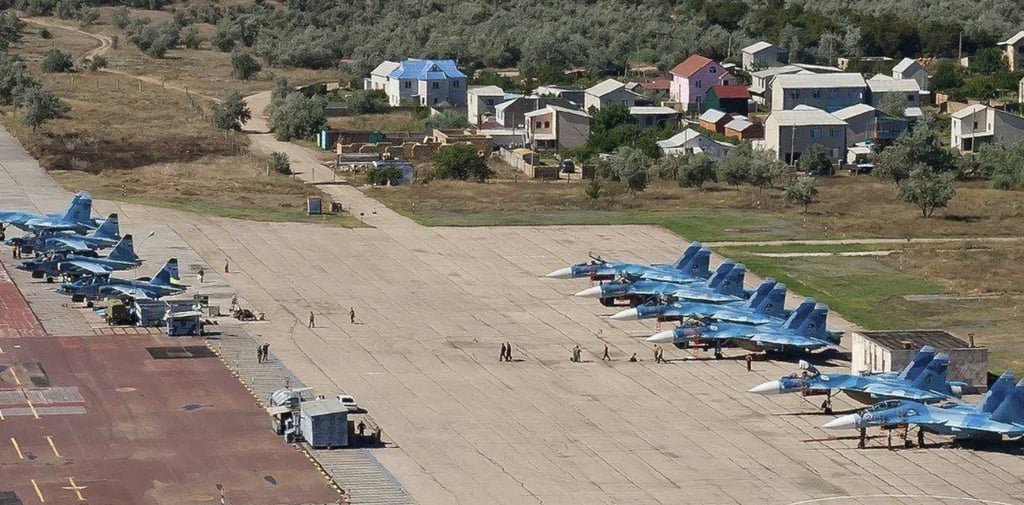Ukrainian Drones Shatter Russian Air Power with Daring Crimea Airfield Assault
Ukrainian special forces carried out a daring drone strike on Russia’s Saky Airfield in occupied Crimea on August 4, damaging five Russian fighter jets and reportedly destroying at least one. The attack, orchestrated by Ukraine’s Security Service, disrupted Russian flight operations and exposed major vulnerabilities in Moscow’s air defenses at a strategically vital location. Satellite imagery and eyewitness accounts confirmed significant damage, fueling rare public criticism within Russian circles and highlighting Kyiv’s growing aptitude for high-impact, asymmetric warfare in the ongoing conflict.
INTERNATIONAL
Thinkbrief
8/3/20253 min read


Ukrainian special forces revealed a stunning show of force this week, launching a high-precision drone attack on Russia’s Saky Airfield in occupied Crimea. As dawn broke on August 4, a squadron of unmanned aerial vehicles breached Russian defenses, targeting the heart of Moscow’s military aviation presence in the region. Satellite imagery later confirmed the aftermath: five Russian fighter jets battered by explosions, with at least one destroyed altogether. Ukrainian officials said the audacious strike disrupted Moscow’s flight operations throughout the day, as fire crews scrambled to contain blazes and emergency services canvassed the tarmac strewn with debris.
The operation, coordinated by Ukraine’s Security Service (SBU), marked one of Kyiv’s boldest attacks since Russia’s full-scale invasion began more than two years ago. According to Ukrainian intelligence sources, SBU operatives had spent weeks surveilling the Saky base, analyzing takeoff routines and pinpointing optimal flight windows for the strike. Their meticulous planning paid off when a volley of drones soared across the peninsula’s airspace, evading electronic jammers and launching devastating payloads in rapid succession.
After the raid, Russian officials conceded several aircraft had sustained damage but refrained from naming models or offering specifics. Open-source analysts and officials in Kyiv pointed to the distinctive silhouettes of Su-27 and Su-30 fighters among the wreckage, noting these jets play a critical role in Russia’s attempts to enforce aerial dominance over the Black Sea. Ukrainian President Volodymyr Zelenskyy, speaking hours after the news broke, praised the SBU’s “remarkable ingenuity and courage,” adding that every strike in Crimea “brings us closer to freeing our land.”
The attack rippled across pro-war Russian channels, stirring rare criticism of Moscow’s air-defense posture. In Crimea, Russian proxies responded by tightening security at military sites and bracing for retaliation. However, Kyiv’s intent came through loud and clear: Crimea remains deeply vulnerable, and Russian air power is far from untouchable.
This latest assault underlines the strategic value of innovative warfare. Ukrainian forces, outgunned on paper, keep leveraging asymmetric tactics deploying low-cost drones against high-value targets with pinpoint accuracy. Defense experts note that even partial airfield shutdowns can cascade through Moscow’s logistics, complicating supply lines and disrupting routine patrols along the front lines and southern coastline.
As smoke cleared over Saky, Russia’s ministry of defense issued vague assurances, insisting most drones were allegedly shot down and that losses were minimal. Independent observers, pouring over satellite photos, documented at least five heavily damaged jets and widespread fire damage across the installation. The scale of destruction contradicts Moscow’s attempts at damage control and is likely to drive intense debate within the Russian military command.
Ukraine’s strike at Saky fits a broader pattern of escalating pressure on Crimea, signaling a willingness to challenge Russian control over the annexed peninsula. With each successful operation, Ukrainian forces erode the perception of Moscow’s invulnerability while raising the cost of occupation. Military analysts point out that targeting aircraft on the ground strikes both symbolic and practical blows showcasing Kyiv’s reach and hobbling Russian operational flexibility in the Black Sea and southern Ukraine.
In the weeks ahead, Western officials expect further Ukrainian drone raids and long-range strikes across occupied territories. The message from Kyiv is unwavering: No Russian airfield in Crimea is safe, and the battle for control over the peninsula is far from over. With air bases on edge and morale shaken, Russia must now reckon with a foe determined to break the status quo, one precision strike at a time.
Ukrainian officials have promised to maintain relentless pressure, vowing that “Crimea will be returned, not as a symbol, but as a fact.” The Saky operation places that promise center stage, offering a stark reminder that resolve, innovation, and daring can upend even the best-equipped adversary. Recent events reinforce what is becoming increasingly clear: the fight for Crimea plays out not only in trenches, but in the sky, on runways, and in the strategies that define modern warfare.